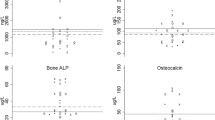Abstract
Sclerostin is produced almost exclusively by osteocytes, which also express receptors for 1,25 dihydroxyvitamin D3. The aim of this study was to investigate the effects of vitamin D3 treatment on serum sclerostin levels in young adult females with severe vitamin D deficiency. A total of 26 subjects were treated orally with calcium (1.200 mg/day for 2 months) and vitamin D3 (300.000 IU/week for 1 month). Serum 25-hydroxyvitamin D (25(OH)D) and sclerostin levels were measured before and after treatment. Baseline serum 25(OH)D and sclerostin levels were at 5.7 ± 2.4 ng/mL and 39.1 ± 14.4 pg/mL, respectively. Serum 25(OH)D was significantly increased, to 62.4 ± 18.7 ng/mL, following treatment; serum sclerostin was significantly decreased, to 29.3 ± 8.8 pg/mL. We conclude that serum sclerostin level is decreased following vitamin D3 treatment in patients with vitamin D deficiency.

Similar content being viewed by others
References
Girgis CM, Clifton-Bligh RJ, Turner N, Lau SL, Gunton JE (2014) Effects of vitamin D in skeletal muscle: falls, strength, athletic performance and insulin sensitivity. Clin Endocrinol (Oxf) 80:169–181. doi:10.1111/cen.12368
Holick MF (2006) Resurrection of vitamin D deficiency and rickets. J Clin Invest 116:2062–2072
Gaudio A, Pennisi P, Bratengeier C, Torrisi V, Lindner B, Mangiafico RA, Pulvirenti I, Hawa G, Tringali G, Fiore CE (2010) Increased sclerostin serum levels associated with bone formation and resorption markers in patients with immobilization-induced bone loss. J Clin Endocrinol Metab 95:2248–2253. doi:10.1210/jc.2010-0067
Robling AG, Niziolek PJ, Baldridge LA, Condon KW, Allen MR, Alam I, Mantila SM, Gluhak-Heinrich J, Bellido TM, Harris SE, Turner CH (2008) Mechanical stimulation of bone in vivo reduces osteocyte expression of Sost/sclerostin. J Biol Chem 283:5866–5875
Lombardi G, Lanteri P, Colombini A, Mariotti M, Banfi G (2012) Sclerostin concentrations in athletes: role of load and gender. J Biol Regul Homeost Agents 26(1):157–163
van Bezooijen RL, ten Dijke P, Papapoulos SE, Löwik CW (2005) SOST/sclerostin, an osteocyte-derived negative regulator of bone formation. Cytokine Growth Factor Rev 16:319–327
Mirza FS, Padhi ID, Raisz LG, Lorenzo JA (2010) Serum sclerostin levels negatively correlate with parathyroid hormone levels and free estrogen index in postmenopausal women. J Clin Endocrinol Metab 95:1991–1997
Costa AG, Bilezikian JP (2012) Sclerostin: therapeutic horizons based upon its actions. Curr Osteoporos Rep 10:64–72. doi:10.1007/s11914-011-0089-5
Neve A, Corrado A, Cantatore FP (2012) Osteocytes: central conductors of bone biology in normal and pathological conditions. Acta Physiol (Oxf) 204:317–330. doi:10.1111/j.1748-1716.2011.02385.x
Peterlik M, Kállay E, Cross HS (2013) Calcium nutrition and extracellular calcium sensing: relevance for the pathogenesis of osteoporosis, cancer and cardiovascular diseases. Nutrients 5(1):302–327. doi:10.3390/nu5010302
Cidem M, Usta TA, Karacan I, Kucuk SH, Uludag M, Gun K (2013) Effects of sex steroids on serum sclerostin levels during the menstrual cycle. Gynecol Obstet Invest 75:179–184. doi:10.1159/000347013
Cidem M, Kara S, Sarı H, Özkaya M, Karacan I (2013) Prevalence and risk factors of vitamin D deficiency in patients with widespread musculoskeletal pain. J Clin Exp Invest 4(4):488–491. doi:10.5799/ahinjs.01.2013.04.0330
Dawson-Hughes B, Harris SS, Ceglia L, Palermo NJ (2014) Effect of supplemental vitamin D and calcium on serum sclerostin levels. Eur J Endocrinol 170:645–650. doi:10.1530/EJE-13-0862
Burger EH, Klein-Nulend J (1999) Mechanotransduction in bone–role of the lacuno-canalicular network. FASEB J 13(Suppl):S101–S112
Santos A, Bakker AD, Klein-Nulend J (2009) The role of osteocytes in bone mechanotransduction. Osteoporos Int 20:1027–1031. doi:10.1007/s00198-009-0858-5
Need AG, O’Loughlin PD, Morris HA, Coates PS, Horowitz M, Nordin BE (2008) Vitamin D metabolites and calcium absorption in severe vitamin D deficiency. J Bone Miner Res 23(11):1859–1863. doi:10.1359/jbmr.080607
Acknowledgments
This study was supported by financial support from the authors of this manuscript. The authors thank Prof Safak Sahir Karamehmetoglu, M.D., for excellent assistance. Unique protocol IDs were obtained (BEAH FTR-7 and NCT01553344) during trial registration at www.clinicaltrials.gov.
Conflict of interest
The authors declare that they have no conflict of interest.
Author information
Authors and Affiliations
Corresponding author
Rights and permissions
About this article
Cite this article
Cidem, M., Karacan, I., Arat, N.B. et al. Serum sclerostin is decreased following vitamin D treatment in young vitamin D-deficient female adults. Rheumatol Int 35, 1739–1742 (2015). https://doi.org/10.1007/s00296-015-3294-1
Received:
Accepted:
Published:
Issue Date:
DOI: https://doi.org/10.1007/s00296-015-3294-1




